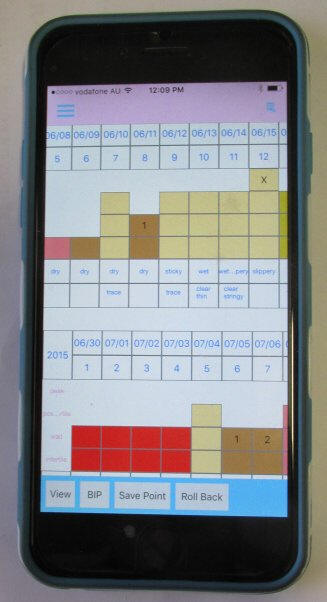Catholic Medical Quarterly Volume 66(1) February 2016
Billingsmentor: A New Approach to Charting and Learning NFP
 BillingsMentor
have announced an App for Natural Family Planning. billingsMentor® is now
available for iPhones and for Android phones. It is a fully interpretive
system for the Billings Method. There are interfaces for seven languages
in the one download.
BillingsMentor
have announced an App for Natural Family Planning. billingsMentor® is now
available for iPhones and for Android phones. It is a fully interpretive
system for the Billings Method. There are interfaces for seven languages
in the one download.
BillingsMentor avoids the use of stamps and symbols by visualising fertility as a simple bar chart that combines fertility with the rules of the Billings Method. This is an important aspect of the e-learning experience. billings-Mentor® was first released as a web service in 2009 and has been under continuous monitoring, improvement and development. All data, whether submitted from cell phone, tablet or desktop is stored on the billingsMentor® server. Thus up-to-date fertility charts are always available from the internet, and are recoverable in the case of a lost or stolen phone.
BillingsMentor offers a new data entry form and additional guidance for entering your fertility symptoms. Users have the option of learning the Billings Method independently by using the automated guidance of the web service, or with a fertility educator. billingsMentor® supports streams for teaching or medical purposes. In order to be allocated to a particular teacher or professional, intending clients must be using billingsMentor® via App or web interface and send a request.
Audrey and John Smith, the creators of billingsMentor® told us that the App is of great help to any woman who wants to learn fertility awareness while avoiding the use of contraceptive drugs or devices.
For more information on the origins of billingsMentor® and links for downloading the iPhone and Android Apps see www.billingsmentor.org
References
- National Fertility Conference in Australia reveals new directions for natural family planning (NFP)" Catholic Medical Quarterly Volume 65(2) May 2015
- Audrey D. Smith; John L. Smith: billingsMentor: Adapting natural family planning to information technology and relieving the user of unnecessary tasks; Linacre Quarterly, Volume 81, Issue 3 (August, 2014), pp. 219-238.
